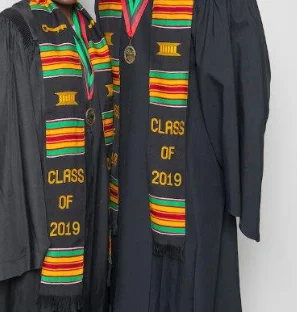Have you wondered about the significance of wearing a stole for your master’s degree? As I navigated the graduation attire landscape, the debate around donning a stole intrigued me.
In this exploration, let’s unravel the importance of stoles in the context of academic achievements, uncovering the traditions and debates surrounding this accessory.
Let me explore symbolic weight and personal choices tied to wearing a stole during the momentous occasion of earning a master’s degree.
What is a Stole?
A stole, in the world of academic regalia, is not just a piece of fabric. It holds meaning, wrapped in tradition. It is more than a stylish addition; it symbolizes achievement and honors.

A stole is a distinctive garment worn during graduation ceremonies. It symbolizes academic achievements and honors. The stole serves as a visual acknowledgement of the wearer’s academic journey and accomplishments.
It is worn draped over the shoulders and falls down the front, displaying various colors and insignias that represent the graduate’s accomplishments and affiliations.
The Role of Stole in Master’s Graduation
1. Symbolism and Significance
In the realm of master’s graduations, the stole isn’t just fabric; it’s a symbol laden with significance, just like a class ring.
Draping it over my shoulders, I feel the weight of achievement and honor. It’s not merely an accessory but a visual testament to the hard work and dedication that led me to this milestone.
2. Representing Academic Achievements and Honors
Worn with pride, the stole in master’s graduations is more than adornment—it is a representation of academic prowess and honors earned.
As I stand, adorned with this fabric signals not just the completion of a degree but the acknowledgement of achievements that set me apart on my academic journey.
3. Conveying Cultural and Personal Expressions
Draped over my gown, it whispers stories of heritage and individuality. It is not just an accessory; it is a piece of self-expression, allowing me to weave my unique narrative into the fabric of graduation tradition.
4. Recognizing Academic Excellence and Achievements
The master’s stole, elegantly donned, serves as a visual recognition of academic excellence and achievements.
It isn’t just a strip of cloth; it’s a marker of the dedication and hard work that paved the way to this moment.
It signifies more than completion—it signifies a journey marked by excellence.
5. Celebrating Specializations or Concentrations
In the tapestry of master’s graduations, the stole becomes a celebratory canvas, highlighting specializations and concentrations.
Draping over my shoulders, it is a personalized proclamation of expertise and focus. Each unique stole is a vibrant brushstroke, painting a picture of the specialized knowledge acquired on my academic journey.
6. Commemorating Cultural or Organizational Affiliations
As I wear the master’s stole, it’s not just about academics; it commemorates cultural or organizational affiliations.

Adorned with symbols and colors, it links me to a broader community. It is a subtle nod to the diverse threads that weave into the fabric of my academic identity.
7. Psychological and Emotional Effects of Wearing a Stole
As it rests on my shoulders, a surge of pride accompanies it, reinforcing a sense of accomplishment.
In addition, it is more than a garment. It is a tangible manifestation of the emotional journey, evoking a mix of achievement, nostalgia, and anticipation.
8. Boosting Confidence and Self-Identity
Wearing the master’s stole isn’t just a matter of tradition; it’s a confidence booster and a declaration of self-identity.
As it embraces me, I feel a surge of assurance—this stole, with its symbolism and history, becomes a tangible affirmation of the academic identity I’ve forged throughout my master’s journey.
How to Position the Stole in Graduation Attire
It typically drapes over the shoulders, falling evenly on both sides. Ensure it sits comfortably, complementing the gown without overpowering it. This simple yet precise placement contributes to a well-balanced and dignified appearance during the graduation ceremony.
Tips Regarding Wearing a Stole
1. Obtaining a Master’s Stole
As I embarked on the journey to obtain my master’s stole, decisions loomed—should I buy, borrow, or rent? Exploring the options, I considered factors like quality, symbolism, and budget.
Choosing between purchase and rental became a reflection of personal preferences. Delving into customization possibilities allowed me to add personal touches, making the stole not just a piece of fabric but a narrative woven with my choices.
In this process, I discovered that the master’s stole isn’t just a garment; it’s a decision-making journey, mirroring the unique considerations and choices of my academic adventure.
2. Debunking Common Myths about Master’s Stoles
Draped in my master’s stole, I navigate through common myths, dispelling misconceptions about its usage.
It’s not just an accessory; it carries a legacy. Addressing confusion surrounding stolen etiquette, I unravel the truth—it’s not a mere fashion statement but a symbol of achievement.
Let’s demystify the master’s stole, acknowledging its significance beyond the fabric and debunking myths that obscure its true essence in the rich tapestry of academic tradition.
3. Stole Etiquette and Protocol
Navigating the realm of master’s stoles involves understanding etiquette and protocol. Draping it with intention, the stole placement carries significance—it rests on the shoulders, a visual embodiment of academic achievement.

Adhering to guidelines, I learned the art of wearing the stole with academic attire, ensuring its alignment with the academic journey.
As I proudly wear this symbol of accomplishment, it’s not just about placement; it’s about following a protocol that honors the academic tradition, acknowledging the legacy behind each master’s stole and the stories it silently narrates in the grand ceremony of graduation.
4. Stole Beyond the Ceremony
Beyond the ceremony, my master’s stole transforms into a symbol of enduring pride and accomplishment.
It is not just a garment; it is a keepsake, preserving the essence of my academic journey. Displayed proudly, it is a tangible reminder of dedication and resilience.
Whether hung as a trophy or carefully tucked away as a cherished memory, the master’s stole extends its significance into post-graduation life, becoming a perpetual symbol of academic feats and the remarkable journey that led to the right to wear it.
Pros and Cons of Stole: The Debate
Advantages
Symbol of Achievement
The master’s stole, a symbol of achievement, embodies the culmination of academic perseverance and success.
Worn with pride during graduation ceremonies, it signifies the journey’s completion, a tangible representation of the hard work and dedication invested in attaining a higher level of education.
Cultural and Personal Expression
Beyond its academic symbolism, the master’s stole serves as a canvas for cultural and personal expression.
Graduates can customize it, incorporating elements that reflect their heritage or personal journey. This individual touch transforms the stole into a unique representation of identity and a celebration of diverse backgrounds.
Memento of Academic Journey
The master’s stole transforms into a cherished memento, encapsulating the essence of one’s academic journey.
It preserves the memories, challenges, and triumphs of the educational expedition, serving as a tangible reminder of the dedication and hard work invested in reaching the milestone of earning a master’s degree.
Disadvantages
Financial Aspect
The financial aspect is a notable concern surrounding master’s stoles. Purchasing or customizing these ceremonial garments can contribute to the overall expenses of graduation.
Mostly, this financial consideration raises questions about the necessity and affordability of an additional component in the already costly process of obtaining a higher education degree.
Uniformity Concerns
Imposing a specific stole design for all graduates can be seen as diminishing individuality, as it may overlook the diverse backgrounds, cultures, and personal journeys represented within the graduating class. The debate centres on balancing tradition and individual expression.
Alternatives to Stoles for Master’s Graduates
1. Exploring Other Commemorative Accessories
Considering alternatives to stoles for master’s graduates, one can explore various commemorative accessories.

These may include unique items such as honor cords, academic medals, or distinctive badges. Each accessory can carry its symbolic meaning, allowing graduates to choose items that resonate with their achievements and personal preferences.
Exploring these alternatives provides an opportunity for individuality while maintaining the tradition of recognizing academic accomplishments during the graduation ceremony.
2. Cultural or Program-Specific Graduation Traditions
Embracing cultural or program-specific graduation traditions adds a meaningful layer to the celebratory experience.
These traditions enhance the richness of the graduation event from unique rituals to specialized ceremonies.
Whether it is a cultural dance, a symbolic gesture, or program-specific rituals, these traditions foster a sense of community and identity among graduates.
They contribute to a memorable and diverse graduation celebration, where each participant feels deeply connected to their heritage, academic program, or both.
The incorporation of such traditions enriches the overall graduation experience, making it more inclusive and reflective of the graduates’ backgrounds and journeys.
Conclusion
Finally, the debate surrounding wearing a master’s stole reflects the nuanced perspectives on tradition, individuality, and the symbolic essence of academic achievements.
Tips on wearing it are subjective, emphasizing personal comfort and pride. Whether draped over the shoulders or worn with specific intent, the stole remains a personal choice.
As you prepare to wear your, acknowledge the significance it holds for me – a symbol of dedication and accomplishment.
Ultimately, the debate underscores the diverse ways individuals approach and value this tradition, leaving room for personal interpretation in this meaningful aspect of the graduation experience.
